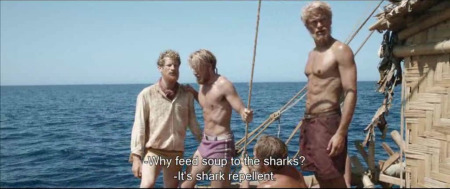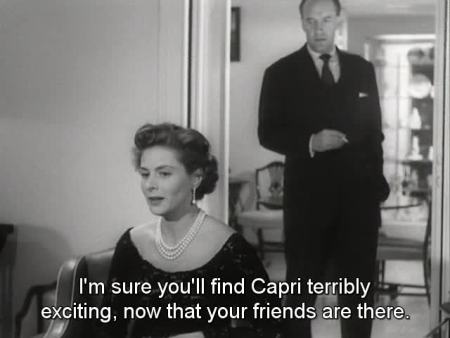For some people who live in the United States, this weekend will be their first opportunity to see Norway’s 2012 Best Foreign Language Film nominee Kon-Tiki in a movie theater. Sort of. In point of fact, nobody in the United States, not this weekend nor during the film’s limited roll-out, is going to see the film nominated for that Oscar, unless it’s because they’ve imported the unsubtitled DVD from Europe. Because the version of Joachim Rønning and Espen Sandberg’s movie playing in the States is a combination of footage from the “real” version that played in Norway, with dialogue sequences re-shot in English. It is, literally, a different movie, with the exact same plot and shot setups.

(The New York Times had a nifty little demonstration of the two versions a couple of weeks back)
We’re not here to rip apart the Weinstein Company for releasing that version (though seriously, it’s pretty dumb – the audience for Kon-Tiki in English is certainly not significantly larger than the audience for the original version), but to consider the greater questions it raises about watching foreign language movies in the first place. I assume that you, like me, are at least a little bit offended by this bit of Anglophonic pandering, and would all things considered, rather see Kon-Tiki in its original version, and the question I ask both you and myself is: why?
English-speaking film fans have for quite a long time been used to thinking of subtitled movie as being the only legitimate way to watch a movie that wasn’t shot in English, but it wasn’t always so. As recently as the 1980s, genre films like Crouching Tiger, Hidden Dragon or The Raid: Redemption would have been dubbed, not subtitled, and even today, in those few occasions with Japanese anime gets a theatrical release, it tends to be dubbed into the local language. And of course, if we go back far enough, examples on the Kon-Tiki model of movies being filmed in multiple languages at the same time used to be quite common. The most famous example is the 1931 Bela Lugosi picture Dracula, for which a Spanish-language production directed by George Melford was produced on the same sets with the same props (and it’s different enough from the original version that many people – I’m among them – don’t simply regard it as a separate movie but a substantially better one), but the traditional of making multilingual copies was fairly common in the ‘30s, especially in Europe.
Decades of practice have ensured that we tend to regard subtitled films as the most “authentic”, given that they’re closest to the version the director had in mind, but this is as much a convention and cultural opinion as anything else. Even the hallowed idea of The Director’s Intent isn’t necessarily meaningful. The Italian director Roberto Rossellini’s preference wasn’t that viewers should watch his movies in Italian, but in whatever their native language was, for example, and even then he slightly re-edited some of his films, notably the iconic Journey to Italy, based on which country that version was going to be seen in. Meaning that Rossellini’s “Directorial Intent” was based less on himself than on you, the person watching.
 This image makes Roberto Rossellini sad
This image makes Roberto Rossellini sad
It’s easy for an Italian to adopt that kind of attitude, because at that point in time, Italian films didn’t have synchronized sound in the first place: everything screened in Italy was dubbed. For Rossellini to thus demand that Americans watch his movies dubbed into English would have seemed absolutely no big deal at all. For Americans, though, dubbing looks patently artificial and cheap: the only American films to be recorded without on-set sound are the very lowest of the low, grade-Z trash like The Beast of Yucca Flats, and the idea of a movie character’s mouth moving in an even slight misalignment with the sounds they’re making drives us mad. It’s the reason that even the very best-made and most imaginative of the Godzilla movies have long been lumped in among the famously bad schlock B-movies of the ‘50s and ‘60s: for an extremely long time, the only way to see them in the English language world was in the form of rather hokey looking dubs. Even here in 2013, you have to be prepared to trek into legally vague places if you want to see many of the Godzilla films in the original Japanese with subtitles.
That leaves us with the question, though: are subtitles clearly the way to go? Any American cinephile will say yes without hesitation, but it’s not a perfect solution. I vividly recall the awareness I had in watching Béla Tarr’s The Turin Horse for the first time, that I wasn’t getting the full effect: the first few minutes of that movie are a black screen with narration being read out loud, and given the way the movie proceeds to plunge us into a grainy monochrome end-of-the-world scenario, it seems pretty clear that directorial intent in this case was that we’d be plunged into absolute darkness for that opening monologue, only to be born into the sickly world of the film. One thing that bright white lettering against a black background surely isn’t, is absolute darkness: the exact opposite, in fact, and sitting there, being aware that the text I absolutely required in order to comprehend one syllable of the Hungarian words being intoned was also creating a visual element that wasn’t just unintended, but actively deleterious to the mood the film was creating. At a slightly more prosaic remove, how many of us have that subtitle-hating friend who “doesn’t like to read movies” – the implication not being that the friend is illiterate, but that if you’re looking at words at the bottom of the screen, you’re not as focused on the images behind them.
 Regardless of how we approach a foreign production – subbed, dubbed, or remade – there’s still always going to be a level of remove. To return to Kon-Tiki, where we started: the movie isn’t just in Norwegian, there’s also Swedish and English spoken, and the distinction between the former two is important; but they’re close enough that a non-Scandinavian would have a hard time telling them apart. That’s the sort of thing that cannot be replicated in any translation medium, just the same as puns and nuances of line readings simply cannot be ported over. Watching a foreign film, like reading a foreign book, is always going to include some measure of compromise and translation.
Regardless of how we approach a foreign production – subbed, dubbed, or remade – there’s still always going to be a level of remove. To return to Kon-Tiki, where we started: the movie isn’t just in Norwegian, there’s also Swedish and English spoken, and the distinction between the former two is important; but they’re close enough that a non-Scandinavian would have a hard time telling them apart. That’s the sort of thing that cannot be replicated in any translation medium, just the same as puns and nuances of line readings simply cannot be ported over. Watching a foreign film, like reading a foreign book, is always going to include some measure of compromise and translation.
The solution to all this is simple: every serious film fan has to be fluent in every single language in the world.